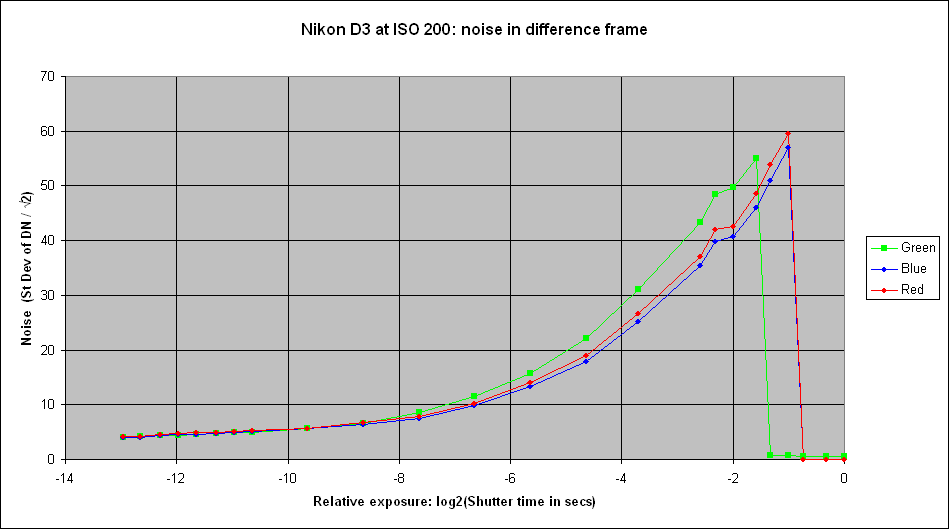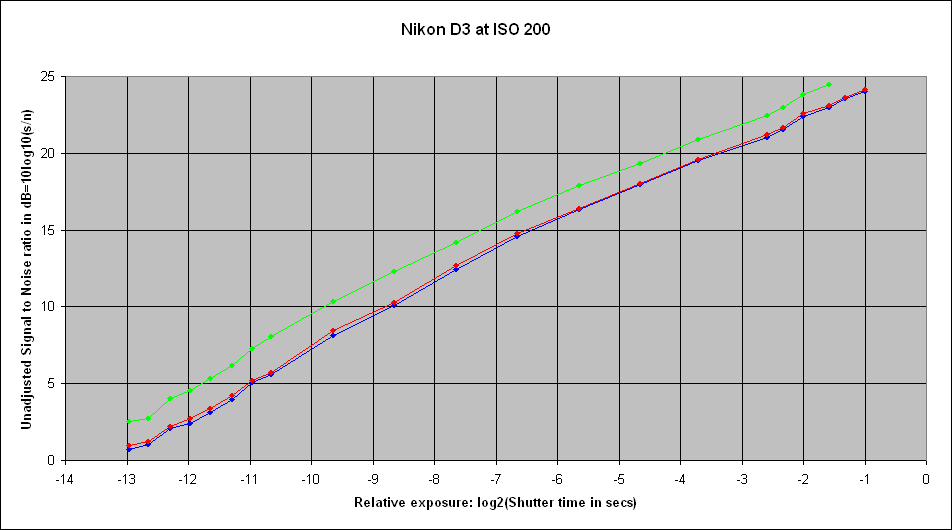The target was a white board lit uniformly. A 70mm lens was used at a distance of 1.5m but focussed at infinity; hence the target was heavily defocused in order to obscure any non-uniformities of the board. The camera was set on manual exposure at f/11. This aperture was chosen because a larger one tends to spread out the signal across the camera's histogram.
The shutter speed was varied over a range from 1 second to 1/8000 of a second so as to cover the full range of exposures from off the lefthand end of the camera's histogram to off the righthand end.
Two shots were taken at each exposure setting. The first shot of each pair gave the mean value of the signal. The two shots were then subtracted and the standard deviation of the difference calculated. The noise is that figure divided by the square root of 2. These calculations were done on a 200 x 200 pixel crop from the centre of the images.
The purpose of the subtraction is to remove, as far as practicable, variations in the signal due to non-uniformity of the target or its lighting, spatial non-uniformity of the sensor response, or dust on the sensor. All of these would be the same for the two shots and are therefore removed upon subtraction.
The camera was set to write 14-bit raw files and all in-camera noise reduction options were turned off. The raw files were processed in such a way as to extract the numbers (referred to as DN for data number) without any alteration. The raw file was split into its red, green and blue components, but no Bayer interpolation (or 'demosaicing') was done.
The statistics of the green component before subtraction are shown in the table here.
The table below shows statistics of a 200 x 200 pixel area in the centre of each image for the green component after the two frames have been subtracted.
It should be noted that the top five exposures are at or close to saturation, and this is the reason why their standard deviation is lower.
These figures are plotted below:

The nasty kink in these curves occurs at a shutter speed of 1/4 sec. Unfortunately, I cannot repeat these measurements to check if it is an experimental error or a real effect. Although it is approaching saturation, I don't think that is the cause as the kink occurs at the same exposure for all three colours whereas the colours reach saturation at different exposures (due to non-white illumination of test target).
The signal to noise ratio is plotted below on logarithmic scales:

Please note that the vertical decibel scale is 10*log10() and not the 20*log10() used in the audio industry. That is because in audio electronics the sound power is proportional to the square of the voltage, whereas in optics we are counting photons and therefore the voltage is directly proportional to the signal power. Is this wrong? Norman Koren of Imatest tells me that Kodak specifies the S/N of their sensors in 20*log10(). But, unless it can be shown that the voltage out of the sensor is measuring the square root of the incoming light power, I say they are wrong! Can some engineers email me and sort this?
The S/N ratio of the green at saturation behaves differently from that of the blue and red because the latter two colours are clipped whereas the green is not. The green signal therefore retains some dispersion at saturation due to residual Shot noise and manufacturing tolerances on the size of individual sensor wells, whereas for the red and blue the S/N ratio goes to infinity at clipping.
One can read a useable dynamic range for the camera at ISO 200 off the above graph:
By adopting 3dB as the lower bound, rather than the read noise, we are requiring the signal to be at least twice the noise in the shadows. I consider that
to be more reasonable from a photographic point of view.
When interpreting this result, two aspects of the method used here should be noted. First, because we subtract two frames before measuring the noise, the noise measurement we get excludes fixed variations arising from uncorrected differences in the sensitivity of individual pixels. Second, the dynamic range is calculated from a sequence of shots, rather than being measured directly from a single shot. That means that any limitation upon dynamic range imposed by the lens, for example due to flare, is excluded. Practical photography has to contend with both of these aspects.
My figures are somewhat higher than those obtained for the D3 by DIWA Labs Nikon D3 2008.01.06 using entirely different methodology. Their assessment of dynamic range uses a lower limit upon S/N ratio of 1 dB which corresponds to a ratio of 1.12, whereas I am using 2. They therefore take more of the low end of the response curve into their dynamic range, but still come up with lower DR figures.
The original raw (NEF) files on which this test is based may be downloaded here. Please note that each file is 10 to 13 megabytes in size, and the whole lot amount to just over 500 megabytes, so you'd have to be really keen to try it.
I'd appreciate a reference to this work if you publish anything based on these files.
Right click and SAVE AS (note that, despite what Internet Explorer might say, these files are .NEF not .TIF):-
NEF files no longer on server. Email me if you want them.
Peter Facey, Winchester, England
20131125 Data files removed from server
20080216 minor clarification
20080127 data files added
20080123 originated